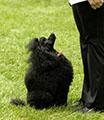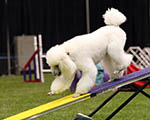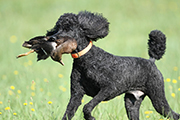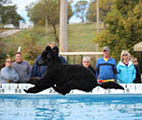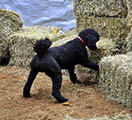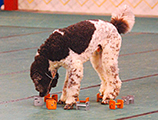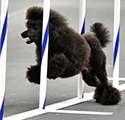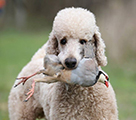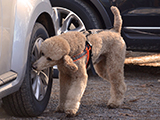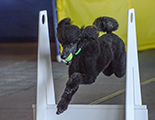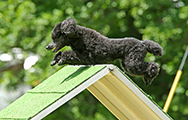Educating the Infant Puppy (Birth to Nine Weeks)
By Grace L. Blair, M.D.
(c) VIP revision 1998
Introduction:
We have developed a series of tests and exercises for baby puppies, which both educates and evaluates each puppy as it grows and develops. These methods are based upon Clarence Pffafenberger’s book, New Knowledge of Dog Behavior, Howell Book House, Inc., 1977, and research publications from many institutions of higher learning. Modifications have been developed which evaluate puppy aptitude and channel their interests into venues desired for a Versatile Poodle. These methods have been developed and refined over nearly twenty years of raising puppies and will continue to evolve as more knowledge and experience is gained.
Because of research with rats, mice and puppies we know that newborn puppies (and even intrauterine puppies) can learn. By day 21 all of the puppy’s senses are intact, the last to “hook-up” is hearing. By 16 weeks of age the basic character of the dog appears to be formed.
It is assumed that you are starting with a litter of puppies whose parents have passed all of the VIP recommended health tests for the breed and have excellent temperaments and conformation.
Goals:
We are endeavoring to maximize the potential of each puppy by stimulating its learning ability, interests and natural instincts. By utilizing the tests and exercises in this guide we hope to develop and identify a group of alert, friendly, fearless, inquisitive, happy, and smart adult Poodles.
Methods:
We intend to stimulate all of the senses as they first begin to develop and we pay particular attention to the 4 Critical Periods of development as defined by Paffenberger.
- Day 1-19, baby puppies need warmth, food, massage, sleep
- Day 20-49, infant puppies learn to play, learn limits, and learn dominance
- Day 50-84 (7-12 weeks) puppies learn independence and relationships with people and other animals, and they learn fear
- Week 12-16, puppies learn self-confidence, housebreaking, that they must obey and the difference between play and work
IDEAS FOR STIMULATING THE VARIOUS SENSES:
Smell: breeder’s hand, orange peel, nail polish, bird feather, bread, meat, cat hair, carrot, etc.
Touch: cool metal, pan of sand, ice cube, pan of gravel, terry cloth, cotton sheet, nylon cloth, tile, brick surface, wool mat, newspaper, plastic, screen, metal floor grate (place puppy on these various surfaces from day 3 onward).
Hearing: clapping hands, pounding on wall and door and floor, dropped cake pan onto floor, radio, voice (loud, soft, variety of voices), bell, cap gun, bird, vacuum, clock.
Vibratory: Vacuum cleaner, clock ticking, mixer, hair dryer.
Sight: people, other animals, TV, toys, cars, machines, trees, everything that you can think of.
Taste: Begin at day 21, use your imagination, they tend to taste all new things, floor, rocks, you, toys.
Guide for Daily Testing and Training:
| Day | Activity |
| 1 | Examine and handle each puppy, hold them in various positions (see Note-day 1 below) |
| 2 | Repeat day 1 and stimulate touch 4-5 seconds |
| 3 | Repeat day 2 plus trim nails and stimulate smell |
| Dewclaws may be removed and tails docked on day 3 or 4 | |
| 4 | Handle, hold in various positions, stimulate touch and smell, put each puppy singly into a shallow metal pie tin and time how long it takes puppy to crawl out of tin onto wool pup rug (see Note-day 4 below) |
| 5 | Repeat day 4 plus stimulate vibratory sense |
| 6 | Repeat day 5 |
| 7 | Repeat day 5 plus trim nails |
| 8-10 | Repeat day 5 |
| 11 | Repeat day 5 plus trim nails and stimulate sight if eyes open |
| 12 | Repeat day 5 plus stimulate sight and move from whelping box into exercise or play pen, place puppy see-saw in pen on one or two inch elevation for minimal motion |
| 13,14 | Continue all of above plus introduce toys, spend at least 15 minutes three times a day sitting in pen and playing with puppies, begin introducing well-behaved children into pen for short periods of play. |
| 15 | Trim nails and begin individual work with each puppy for 5 to 15 minutes each day |
| 16-19 | Continue above, introducing more and more variety of toys, cats, people, noises |
| 20 | Begin auditory stimulation and put legs under teeter-totter to raise it about 8 inches from floor; leave a radio playing in puppy room for most of the day from now onward. |
| 21 | (first day they can hear!) Hang a play object from ceiling just within reach of puppies, and raise it higher up as they grow |
| Play with puppies as a group and individually, include lots of noise, laughing, cuddling, and petting, continue holding in various positions | |
| First bath and shave and another nail trim, start feeding puppies and discharge a cap gun prior to each time of placing pan of food before puppies | |
| 22-49 | Daily play, learning “no bite”, there are no bad or frightening noises, introduce foods, continue twice a week nail trims, do 2nd grooming, introduce to water pool (do not force puppies into pool, put toys in pool and if they go in spontaneously fine, if not just leave them alone. A good way to make a puppy afraid of water is to force them into a pool at this age. Teach them that you can examine their mouths, ears etc; do “follow me” and retrieving play. Introduce to people of all types, introduce to other animals, birds, etc., stack on grooming table daily |
| 49 | Start night crate training separate from siblings, start housebreaking and learning specific places to “go”, weaning is complete, separate from mother except for playtime. begin leash training, car rides, introduce to heights Giving and then taking food away and out of mouth. |
| 63 | Begin introduction to tracking and to birds, obedience, agility and other activities- making it all lots of fun. Probably tracking is the easiest to do and the most fun (with no corrections) at this age |
*NOTES
Day 1– You will find pups which are very comfortable being on their backs while on your palm, others which struggle slightly and then relax and others which just can’t relax when on their backs. These latter pups need lots of socialization and rarely become the top working dogs. They tend to be more noise sensitive, can panic in stressful situations and have more difficulty in problem solving under stress. Certainly, with work, these can be happy and successful dogs but they do require more work and dedication on the part of the owners. There are some OTCh dogs with this temperament, but they never become reliable service dogs or top field dogs. The ideal working temperament can often be identified on the first day after birth. During the next 8 weeks the intelligent dog with this ideal temperament can then be identified clearly.
Day 4– this is an important exercise as it can pinpoint pups which need more help and those with great potential. You may see a very laid-back puppy which is not concerned about getting out of the pan and just goes to sleep. You may see a puppy which panics and is paralyzed with fear- you can help this puppy to learn to problem solve and to trust you by gently placing 2 fingers beneath its chin and guiding it out of the pan. This pup needs lots of varied exposures of increasing difficulty to help it to overcome fear and to learn problem-solving techniques. You may see a pup which initially panics and then climbs out on its own. You may see a pup which shows great independence and is not afraid, just holds its head up, gives a sniff or two and climbs out of the pan. The next day each pup will show a similar response, but indicate that they remember this “test” and are not as concerned and most will then climb out without help. The laid back pup will usually continue to just go to sleep. This pup is a challenge to motivate all of its life! By day 7 to 10 you will see that most of the pups understand this test and as soon as they are placed in the pan just climb out easily and with no great concern.
GENERAL:
The more things to which a puppy is exposed the more he learns. Talk to them a lot, everything has a name-use it. Never lose patience with a puppy, they need to learn limits, however, from you as well as from mother and littermates, i.e. “don’t bite me” Make everything lots of fun.
Never console a puppy if it is afraid or hurt-make light of and play with a puppy who is afraid-happily continue to introduce him to things he is afraid of-frequently and repeatedly try to find things, which frighten him and repeatedly introduce him to this happily and enthusiastically, he will pick up your attitude with time.
Some authors (Paffenberger) say that during week 10 a puppy is especially vulnerable to fear, this is poorly documented (Fox).
Lots of “good puppy” when he is pleasing you, encourage enthusiasm-this can always be toned down later as puppy matures.
Put floating toys in wading pool and encourage puppy to play in water. (Not if outside in winter in cold climate)
Play hide-and-seek from 8 weeks on as this stimulates their relationship with you, as finding you is their reward, this can transit into tracking training and to decrease the fear of entering into new situations. When they find you-let them know that they are terribly clever–lots of praise and play.
Manufacture games to play with the puppy to solve problems which develop. Pay attention to each puppy and tailor games and new events and stimuli to its needs.
By week 6-7 begin to introduce the clicker if you plan to use clicker training with your dog. This is VERY effective for learning new behaviors at this age.
By week 12 be zeroing in on a favorite toy to use as a “reward play” for tracking, obedience and motivational training. The puppy should only, then, be allowed to play with this object as a direct result of completing a task or a reward for special behavior. This “reward play” should be limited to from a few seconds to 1 or 2 minutes.
Vocabulary: Use the same word to indicate something repeatedly, by 6 months he should have at least a 50-word vocabulary.
BE CONSISTENT, TRAIN YOUR PUPPY TO BE THE ADULT YOU WANT
A word of note about grooming of poodle puppies:
I groom my adult dogs while they are reclining on their side. This includes shaving. At about 5 weeks of age, sometimes earlier with some pups, I begin to insist that they lie on their side for brushing, nail grinding and shaving. This is the age when they begin to learn dominance, and I want them to know that I am dominant to them. The first session of grooming while they lie on their side is difficult and takes time and patience. I begin by holding them on their side and petting and saying “good puppy” until they will stay there with my hands off of them.
Some pups are very mellow and it is an easy task, some of them require going from gentle holding (over a period of about 15 minutes) to tapping them none too gently with the back side of a pin brush, shaking them and plopping them onto the table before they begin to realize that I, in fact, mean for them to stay in what ever position that I put them and to stay there until I tell them it is OK to get up. I think that this session is the most critical to developing a dog that is easy for anyone to groom under any condition. They must realize that I will not tolerate their misbehavior on the grooming table, that I am not going to hurt them if they cooperate and that they get lots of praise and TLC when they are good.
Research has shown that a puppy at this age is perfectly capable of learning this, and I have certainly proven to myself that it works and doesn’t hurt them. (I think that dogs respond well when they feel that you are being fair to them. This means being consistent, using the same word to mean the same thing and not punishing them if they don’t understand what is expected. After this major session the next is much easier, and by the time they are 3 months old examining teeth, pulling hair from ears, shaving, brushing and grinding nails is very easy. When I begin standing them for scissoring they go through a period at about 5 months of age when they think it tickles too much and they decide that they won’t stand to be scissored. This is the time that we have another “session” and they realize that they also can stand on the table and be still even though it tickles and they would rather play. I do spend lots of time playing with my dogs, but they know the difference between play and work and that grooming and scissoring are considered work.
For temperament testing information go to: VIP Temperament Test.
This information is provided in order to help breeders raise puppies that are well balanced mentally with a natural curiosity and increased capacity for learning. These ideas are merely suggestions. Other breeders have many other well thought-out methods of raising dogs of intelligence that work equally well. If you have other methods of infant puppy training which work for you Versatility In Poodles would appreciate hearing about your experiences. We can all learn from each other!
The information contained in these documents is current at the time of this writing and is accurate to the best of VIP’s knowledge.
This information has been provided to you at no charge. You are free to use it provided it is used in its entirety with no changes or alterations and that the copyright remains intact. If you have found this information to be helpful, please consider making a tax-deductible donation to:
Versatility in Poodles
4061 Highlands Rd
Franklin, NC 28734
To make a donation via PayPal, please click the Donate Button:
![]()
The contents of the www.vipoodle.org website, such as text, graphics, images, and other material contained on this site (“Content”) are for informational purposes only. The Content is not intended to be a substitute for professional veterinarian advice, diagnosis, or treatment. Always seek the advice of your veterinarian with any questions you may have regarding the medical condition of your pet. Never disregard professional advice or delay in seeking it because of something you have read on this website!
If you think your pet has a medical emergency, call or visit your veterinarian or your local veterinary emergency hospital immediately. Versatility in Poodles and www.vipoodle.org do not recommend or endorse any specific veterinarians, products, procedures, opinions, or other information that may be mentioned on this website. Reliance on any information appearing on this website is entirely at your own risk.


